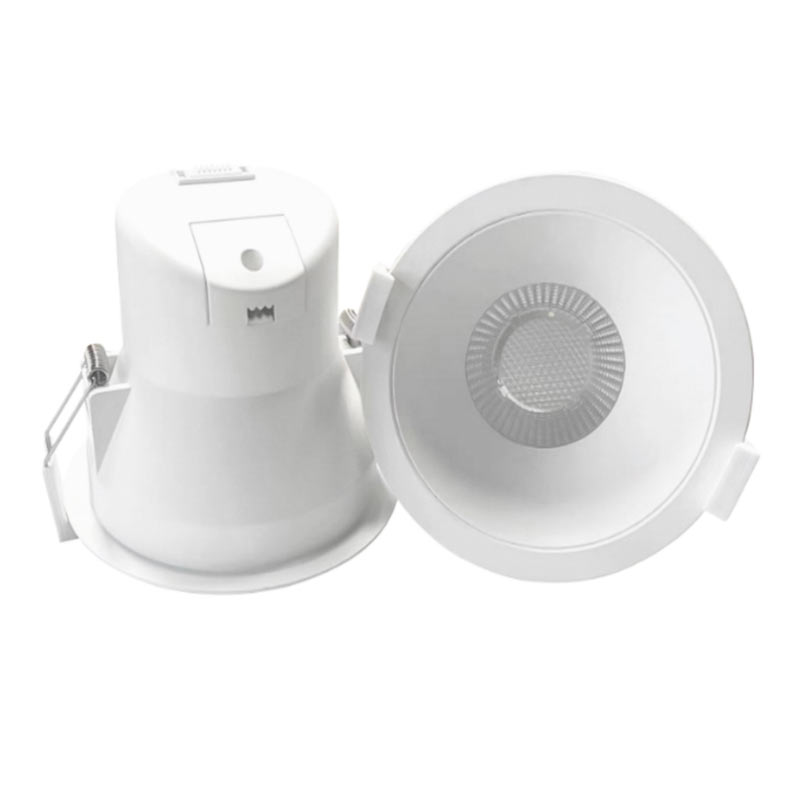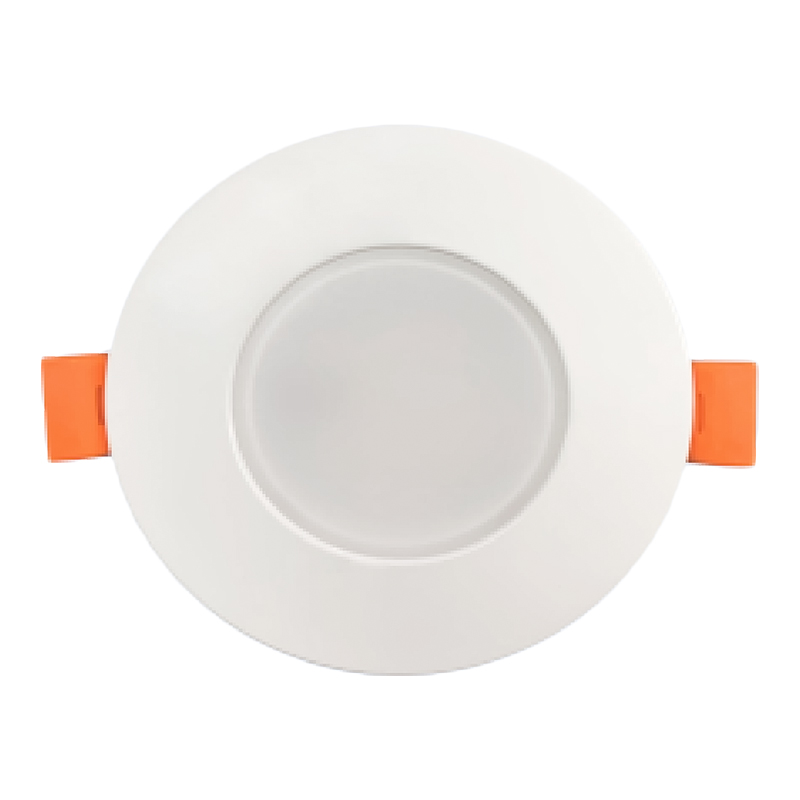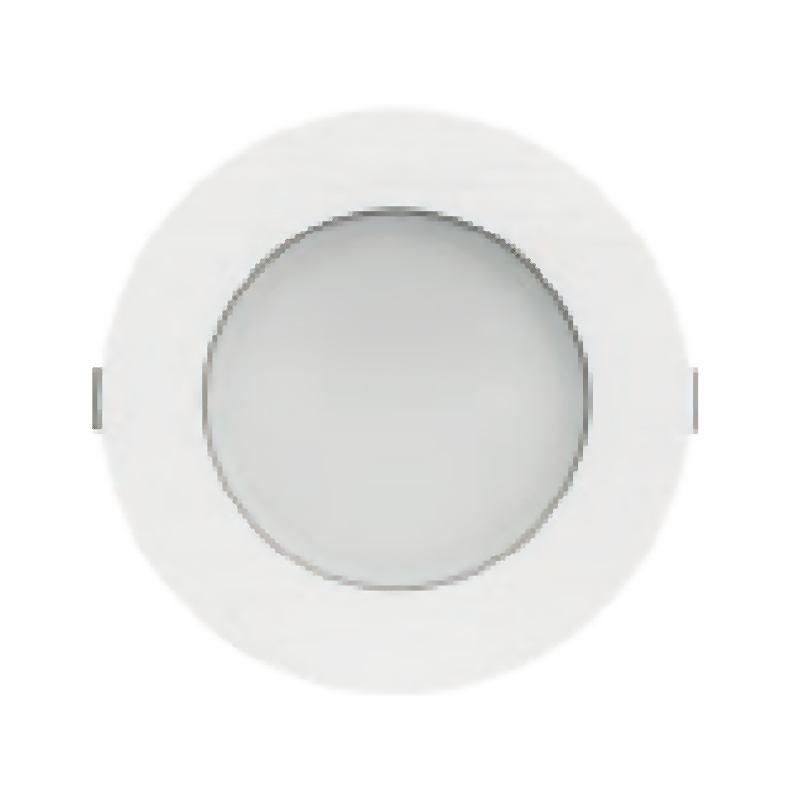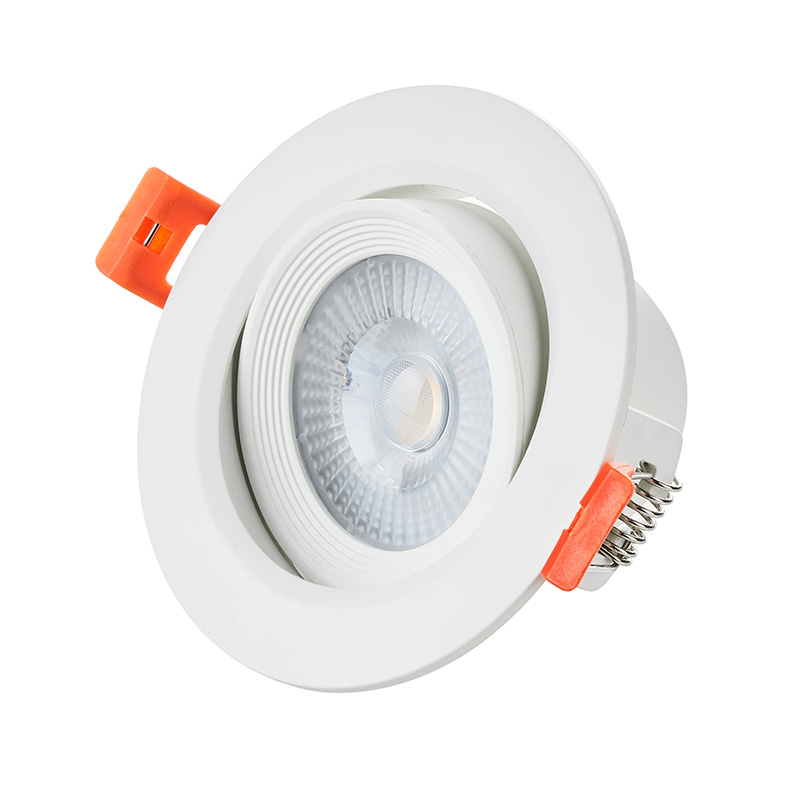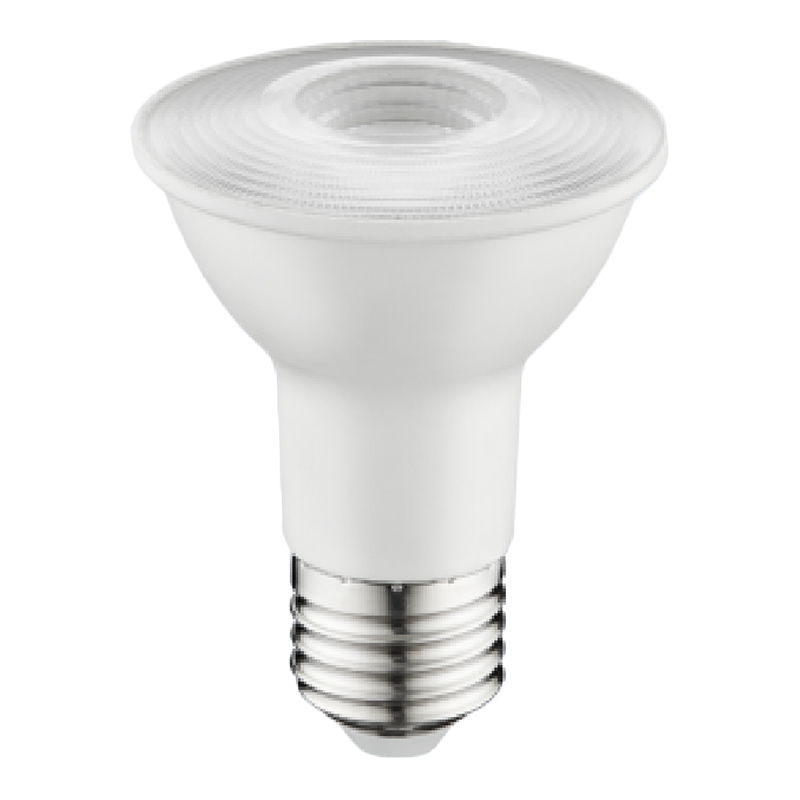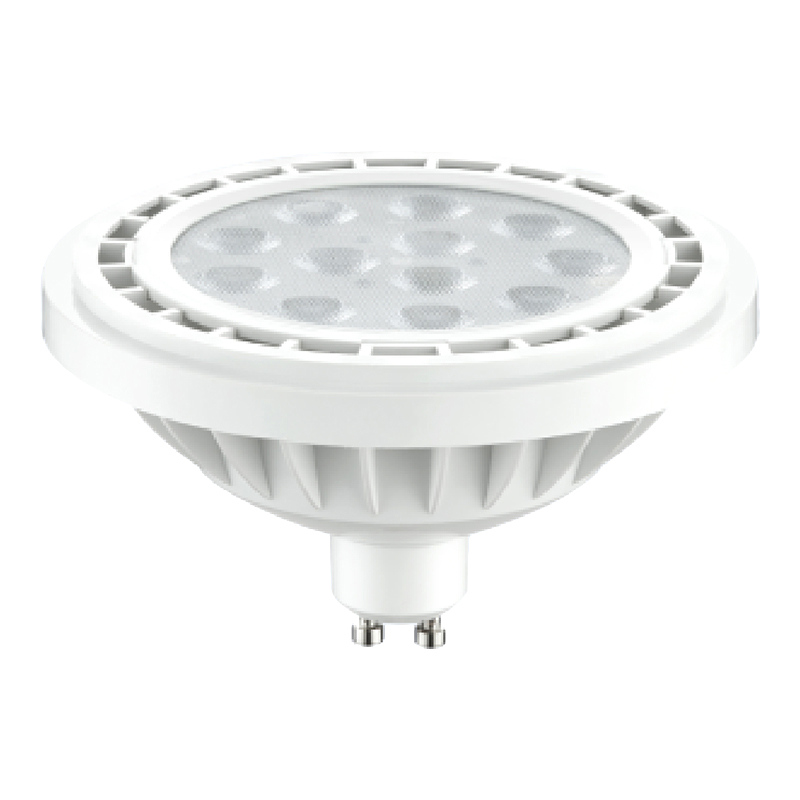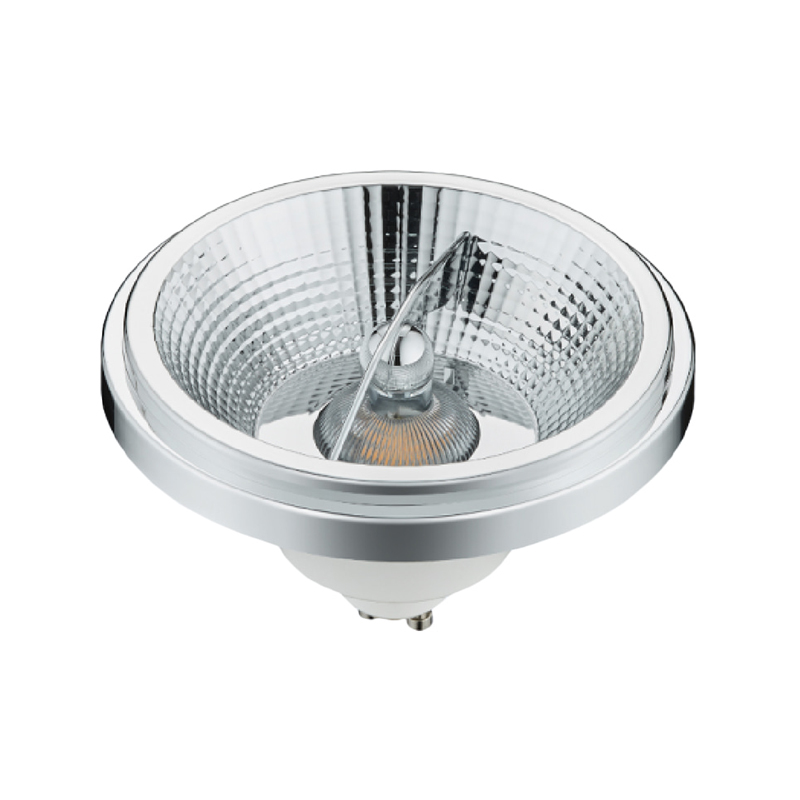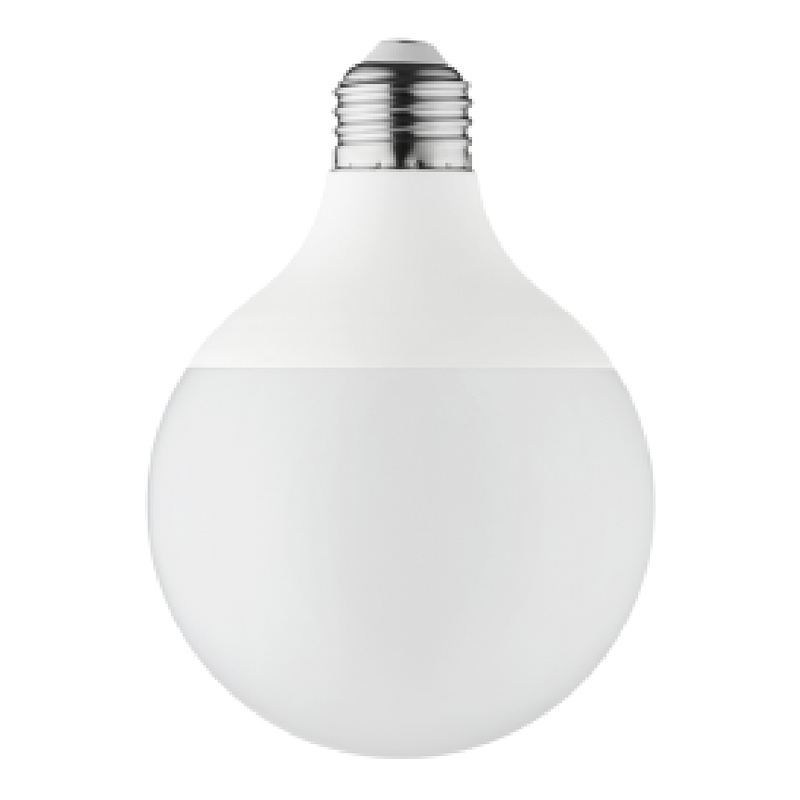Introduction to LED Ceiling Lights LED ceiling lights have become a popular choice for modern homes,...
1. Understanding Modern Lighting: A Look at LED Downlights
Defining LED Downlights and Their Role
LED Downlights, commonly referred to as Recessed Lighting, are lighting fixtures installed within a cutout in the ceiling, where the face of the light is flush with the ceiling surface. They feature a simple design and a discreet appearance, projecting focused light downwards. They are the preferred solution for achieving aesthetic and highly efficient illumination in modern residential and commercial spaces.
LED (Light-Emitting Diode) technology is the core of these fixtures. Unlike traditional incandescent or halogen bulbs that produce light by heating a filament, LEDs emit photons through the movement of electrons within a semiconductor material. This fundamental technological difference results in superior efficiency and longevity.
LED Downlights consist of several key components:
- LED Chip: The actual light-emitting source.
- Heat Sink: A crucial component used to dissipate the heat generated by the LED, ensuring the fixture's lifespan and performance.
- Driver: An electronic component that converts the incoming Alternating Current (AC) into the low-voltage Direct Current (DC) required by the LED chip.
- Housing/Trim: The part that is recessed into the ceiling and the visible, decorative edge.
Downlights' primary uses cover the three fundamental levels of lighting design:
- General Lighting: Providing uniform, basic brightness for the entire space.
- Task Lighting: Offering higher intensity illumination over specific work areas (e.g., kitchen counters, desks).
- Accent Lighting: Highlighting artwork on walls, architectural textures, or decorative elements.
The Rise of LED Downlights in Contemporary Design
The dominance of LED Downlights in the lighting market is largely due to their perfect alignment with the demands of modern interior design for simplicity, functionality, and sustainability.
Their recessed nature means the ceiling surface remains clean and uninterrupted. Compared to pendant or surface-mounted lights, Downlights bring a fluid and open visual feel to a space. Whether the design style is minimalist, modern, or industrial, Downlights integrate seamlessly, providing an efficient light source while maintaining the purity of the design.
The widespread adoption of LED Downlights is primarily attributed to three core advantages:
- Energy Efficiency: Extremely low energy consumption, significantly reducing electricity bills.
- Long Lifespan: Reducing the hassle and cost of frequent bulb replacement.
- Design Flexibility: A rich selection of beam angles, color temperatures, and forms to meet various lighting needs.
A Technical Snapshot: Key Terminology to Know
To correctly select and evaluate the performance of LED Downlights, it is essential to understand several key technical terms:
| Term | Unit of Measurement | Meaning |
| Lumens | lm | Light Output. Measures the total amount of light emitted by the fixture, the main indicator of brightness, replacing the traditional wattage measurement. |
| Kelvin | K | Color Temperature. Measures the warmness or coolness of the light color. Lower values are warmer (more reddish-yellow), and higher values are cooler (more bluish-white). |
| CRI (Color Rendering Index) | 0 - 100 | Color Accuracy. Measures how accurately the light renders the true colors of objects. Higher CRI means colors look more natural and realistic. |
| Beam Angle | Degrees (°) | Light Spread. The narrower the beam angle, the more focused the light, suitable for accent lighting; the wider the beam angle, the more diffused the light, suitable for general illumination. |
2. The Compelling Advantages of Upgrading to LED Downlights
Unmatched Energy Efficiency and Environmental Stewardship
LED technology is the biggest energy revolution in the lighting sector. They can generate a significant amount of light with very little electrical energy, resulting in astonishing energy savings.
1. The Power Comparison: Energy Efficiency Analysis
Compared to traditional halogen and incandescent lamps, LED Downlights consume significantly less energy. The table below compares the typical power consumption of several common lamp types that provide similar brightness (lumens):
| Lamp Type | Typical Light Output (Lumens) | Typical Power Consumption (Watts) | Energy Efficiency Comparison (vs. LED) |
| LED Downlight | 450 - 550 lm | 7 W - 9 W | Baseline (100% Efficiency) |
| Halogen Lamp | 450 - 550 lm | 35 W - 50 W | Efficiency is about 14% - 25% of LED |
| Incandescent Lamp | 450 - 550 lm | 40 W - 60 W | Efficiency is about 12% - 22% of LED |
Conclusion: Replacing one 50W halogen lamp with an 8W LED Downlight can immediately reduce lighting energy consumption by up to 84%.
2. Environmental Benefits: Reduced Carbon Footprint
LED lighting is environmentally friendly. They produce very little heat, which means they can reduce the load on air conditioning systems in cooled environments, further saving energy. More importantly, unlike Compact Fluorescent Lamps (CFLs), LED Downlights do not contain mercury or other harmful heavy metals. This makes them easier to recycle and dispose of at the end of their life cycle, significantly reducing the risk of environmental pollution.
Longevity and Significant Reduction in Maintenance
The exceptional longevity of LED Downlights is another key factor distinguishing them from traditional lamps, directly translating into significant cost savings.
1. Extended Lifespan Comparison
| Lamp Type | Average Lifespan (Hours) | Typical Years of Use (Based on 4 hours/day) |
| LED Downlight | 25,000 - 50,000 | 17 - 34 Years |
| Halogen Lamp | 1,500 - 3,000 | 1 - 2 Years |
| Incandescent Lamp | 750 - 1,000 | Approx. 0.5 - 0.7 Years |
2. Cost Savings: Reduced Replacement Frequency
In commercial spaces or residences with high ceilings, replacing bulbs requires specialized equipment or maintenance personnel, incurring high labor costs. Because LED Downlights have an extremely long lifespan, replacement is often unnecessary for ten or more years, dramatically reducing maintenance costs and associated downtime. Especially in large-scale applications, LED Downlights offer tremendous convenience and economic benefits.
3. Illustrating the Return on Investment (ROI) of LED Downlights
Although the initial purchase price of LED Downlights is often higher than traditional bulbs, when considering the energy savings and reduction in maintenance costs, they typically achieve a return on investment within 1-3 years of installation. Every year thereafter represents pure profit. This rapid ROI makes LED a smart and sustainable long-term investment.
Superior Light Quality and Performance
1. Brightness and Light Output
As mentioned earlier, lumens (lm) are the standard measure of brightness for LED Downlights. LED technology is capable of providing high lumen output, ensuring ample light for any area.
2. Instant-On Capability and Flicker-Free Operation
- Instant Illumination: LEDs do not require a warm-up period when switched on (unlike some older fluorescent lights) and provide full brightness immediately.
- Flicker-Free: High-quality LED Downlights drivers provide stable current, avoiding the subtle flickering that can be imperceptible to the naked eye. Flickering is a cause of eye strain, headaches, and decreased concentration, and flicker-free LEDs significantly improve the comfort of the lighting environment.
3. Light Quality: Color Temperature Range
LED Downlights offer a wide range of color temperatures, allowing users to choose the appropriate ambiance based on the room's function and personal preference:
- Warm White (2700K - 3000K): Soft, comfortable yellow tones, suitable for spaces requiring relaxation and warmth, such as bedrooms and living rooms.
- Neutral White (3500K - 4000K): Balanced white tone, similar to noon sunlight, suitable for kitchens, bathrooms, and studies.
- Cool White/Daylight (5000K - 6500K): Crisp white light with a slight blue tint, suitable for garages, workspaces, or commercial environments requiring high alertness.
Design Flexibility and Aesthetic Versatility
The compact design and customizability of LED Downlights make them a favorite in modern interior design:
- Seamless Integration: Most Downlights can be installed flush with the ceiling surface, providing a minimalist, clean look that does not take up valuable space.
- Style Diversity: They come in various visible decorative trim styles, including flush, sloped, and various colors (white, black, brushed nickel), allowing them to match different interior styles.
- Compact Size: Due to the small size of the LED chip, many modern LED Downlights utilize a "canless" or integrated design, which is ideal for false ceilings with limited space or areas where traditional can lights cannot be installed.
3. Exploring the Diverse Range of LED Downlights
Fixed Downlights
Definition and Structure:
Fixed LED Downlights are the most basic and common type. Their light direction is fixed, projecting light straight downwards without angle adjustment. They typically have simple round or square bezels.
Typical Applications:
- General Lighting: Suitable for providing uniform, wide-area basic illumination, such as hallways, above kitchen islands (if no accent lighting is needed), and large open-plan living areas.
- Advantages: Simple design, sturdy construction, often more cost-effective than adjustable types, and more straightforward to install and maintain.
Adjustable Downlights (Gimbal)
Definition and Structure:
Adjustable LED Downlights, or Gimbal Downlights, have their LED light source module mounted within a rotatable or tiltable inner ring (Gimbal Ring). This allows the user to manually adjust the direction of the light beam after installation.
Ideal Uses:
- Accent Lighting: Suggested for use to highlight specific areas or objects, such as artwork, sculptures, indoor plants, or fireplaces.
- Sloped Ceilings: On sloped ceilings, they can ensure the light can still project straight down or onto the required plane.
Recessed Downlights
Definition and Structure:
Recessed Downlights refer to fixtures where the main body and light source are fully embedded within the ceiling structure, with the visible decorative trim flush with the ceiling. This is the most common and contemporary look.
Key Features:
- Appearance: Provides the cleanest, most minimalist look.
- Suitability: Discuss their suitability for low ceilings and modern interiors, as they do not hang down and visually occupy space, making the room appear taller and more spacious.
Technical Breakdown:
- Traditional Can Lights (Housing): Require a metal housing (the "can" or "pot") pre-installed on the ceiling joists.
- Canless Downlights (Integrated): Modern LED Downlights tend to have integrated drivers, eliminating the need for traditional housing. They clip directly into the ceiling, making installation easier, especially for renovation projects with limited space.
Surface-Mounted Downlights
Definition and Structure:
Surface-mounted Downlights are not embedded but are installed directly onto the ceiling surface. They typically take the form of a shallow cylinder or square "drum" or "panel."
Advantages as an Alternative:
- Ease of Installation: Discuss their ease of installation, requiring no large holes to be cut in the ceiling, only connecting the wires and securing the base, making them an ideal alternative to Recessed Downlights.
- Applicable Environments: Suitable for structures where recessed installation is impossible, such as solid concrete ceilings or areas with no space within the ceiling void.
Dimmable Downlights
Definition and Function:
Dimmable Downlights have the functionality to adjust light brightness. They work with an external dimmer switch via an electronic driver to achieve smooth or stepped brightness adjustment from full light to very low levels.
Core Value:
- Creating Ambiance: Emphasize the benefits of dimmable Downlights for creating ambiance, such as dimming the lights during dinner for a cozy feel, or providing soft background light while watching a movie.
- Additional Energy Savings: When brightness is reduced, energy consumption also decreases, further lowering electricity usage beyond the base energy savings.
Important Note:
- Compatibility: It must be mentioned that compatible dimmer switches are needed. LED drivers require specific electronic dimmers (such as Triac, MLV, ELV, or 0-10V types) to function smoothly. Traditional incandescent dimmers may cause flickering or failure.
Smart Downlights
Definition and Function:
Smart Downlights integrate Wi-Fi or Bluetooth connectivity, allowing users to control them remotely via smartphone apps, tablets, or smart voice assistants.
Enhanced Features:
- Remote Control: Turn lights on/off and adjust brightness from anywhere.
- Tunable White/RGBW: Beyond brightness, users can adjust the color temperature (Tunable White) or choose from billions of colors (RGBW).
- Integration: Discuss their ability to be integrated into smart home systems (such as IoT platforms), linking with other smart devices to create automated scenes (e.g., "Coming Home Mode" or "Reading Mode").
- Scheduling and Grouping: Set timers for switching on/off and group multiple fixtures for one-touch control.
4. Technical Considerations for Choosing the Right LED Downlights
Brightness: Determining the Right Lumens
1. Lumens Measure Light Output
Lumens (lm) are the only standard measure of light output, rather than Watts (which measure power consumption). When purchasing LED Downlights, you should select the lumen value based on the required brightness level.
2. Determining the Right Lumen Level for Different Rooms
Determining lumen requirements usually involves considering the room size and function. Lighting designers often use "illuminance" as a reference.
Below are typical recommended illuminance ranges for different room functions, and corresponding LED Downlights lumen selection guidelines:
| Room Function | Recommended Illuminance Range (Lux) | Typical Downlight Lumen Recommendation |
| Living Room/Bedroom (Ambient Light) | 100 - 200 | 450 - 700 lm |
| Kitchen/Bathroom (Task Lighting) | 300 - 500 | 700 - 1000 lm |
| Office/Study (High Task Demand) | 400 - 750 | 800 - 1200 lm |
| Hallway/Storage (Basic Illumination) | 50 - 100 | 300 - 500 lm |
Practical Guide: You need to calculate the total lumens required for the total room area, and then determine the lumen value each Downlight should provide based on the number of fixtures you plan to install.
Color Temperature: Setting the Mood with Kelvin
Color Temperature is measured in Kelvin (K) and determines the visual color characteristics of the light. Choosing the right color temperature is crucial for the room's atmosphere.
1. Kelvin Scale and Light Color Perception
| Color Temperature (K) | Light Color Description | Atmosphere Perception | Suggested Application Scenarios |
| 2700K - 3000K | Warm White | Warm, relaxing, comfortable | Living rooms, bedrooms, dining areas - Mimics the cozy feeling of traditional incandescent light. |
| 3500K - 4000K | Neutral White | Clean, neutral, clear | Kitchens, bathrooms, hallways - Suitable for areas requiring a balance of comfort and functionality. |
| 5000K - 6500K | Cool White/Daylight | Bright, sharp, invigorating | Garages, laundry rooms, offices, retail areas - Suitable for places requiring high alertness or precise color. |
Beam Angle: Controlling Light Distribution
Beam Angle determines whether the light is focused or diffused. This is key to deciding whether LED Downlights are suitable for general or accent lighting.
| Beam Angle Range (°) | Type | Effect | Suggested Application Scenarios |
| Narrow Beam (15° - 30°) | Spotlight | Highly focused, high shadow contrast | Accent lighting, highlighting artwork, architectural details, or distant surfaces. |
| Medium Beam (30° - 45°) | Moderate Spot | Focused but not glaring, smooth light transition | Task lighting for kitchen countertops or fireplaces. |
| Wide Beam (60° - 100°) | Floodlight | Light disperses evenly, soft shadows | General illumination, suitable for overall ambient lighting in large areas like living rooms and bedrooms. |
CRI (Color Rendering Index): Ensuring True Colors
CRI (Color Rendering Index) measures the ability of a light source to accurately render the true colors of objects, with 100 being the maximum score (sunlight or incandescent light).
- Importance of CRI: CRI is especially important for areas where accurate color judgment is needed (e.g., preparing food in the kitchen, makeup areas, art studios).
- Quality Standard: It is suggested to choose CRI 80 or higher for most applications.
- Professional/High-End Needs: For spaces requiring the highest color accuracy (such as art galleries, high-end retail, or professional studios), CRI 90+ LED Downlights should be selected.
IP Rating: Protection Against the Elements
IP Rating (Ingress Protection) measures the fixture's resistance to intrusion from solid foreign objects (first digit) and liquids (second digit).
| IP Rating | First Digit (Solid Protection) | Second Digit (Liquid Protection) | Applicable Scenarios |
| IP20 | Finger protection | No protection | Dry indoor areas (living rooms, bedrooms). |
| IP44 | Protection against ≥1.0mm solids | Protection against splashing water | Suitable for Bathroom Zone 2 (above the sink, damp areas but not directly sprayed with water). |
| IP65 | Totally dust tight | Protection against water jets | Suitable for Bathroom Zone 1/0 (inside the shower area, directly above the bathtub), or exposed outdoor use. |
Dimmability: Integrating Control
Dimmable Downlights not only allow for light adjustment but also offer further potential for energy savings.
- Dimmer Compatibility: Ensure that the LED Downlights driver you choose is compatible with your dimmer switch type (e.g., Triac or ELV dimmers). Incompatibility can cause flickering, buzzing, or shorten the fixture's lifespan.
- Dimming Range: High-quality LED Downlights should allow for smooth, deep dimming (e.g., down to 1% to 10% brightness) to create the ideal nighttime ambiance.
5. Practical Guide to the Installation of LED Downlights
Crucial Safety Measures and Preparation
The top priority when installing any lighting equipment is safety. Strict precautions must be taken because high-voltage circuits are involved.
- Safety Precautions:
- Power Off First: It is strongly emphasized that the power must be completely turned off at the main breaker before starting any installation work. This includes not only the lighting switch but also the main circuit breaker supplying power to that circuit.
- Verification: Use a voltage tester (such as a non-contact voltage pen) to confirm that there is no electrical current in any wires in the operating area.
- Professional Consultation: If you are unsure about wiring, electrical codes, or ceiling structure, it is recommended to consult a qualified electrician. Especially when undertaking new circuit wiring or operations involving high voltage.
- Follow Codes: Ensure the selected LED Downlights have the required certifications (e.g., UL or ETL certification) and comply with local electrical and building codes.
- Ceiling Rating Check:
- IC Rating (Insulation Contact): Confirm whether the fixture has an IC rating. IC-rated LED Downlights can be in direct contact with ceiling insulation material without an extra thermal barrier, which is a common configuration for modern fixtures.
- Non-IC Rating: If the fixture is non-IC rated, sufficient space (usually at least 3 inches) must be left around the fixture to prevent contact with insulation material and avoid overheating.
Tools and Materials Checklist
Common tools and materials required for an LED Downlights installation project include:
- Tools:
- Electric drill/Impact driver
- Hole Saw/Compass Cutter of appropriate diameter: Select according to the cut-out size specification of the LED Downlights.
- Voltage tester
- Tape measure and pencil
- Screwdrivers (flat-head and Phillips)
- Wire strippers/Cutters
- Safety ladder
- Materials:
- The chosen LED Downlights (ensure the driver or J-Box is included).
- Wire connectors (such as wire nuts/screw terminals)
- Electrical cable (e.g., Romex)
- Electrical tape
- Safety glasses and gloves
Step-by-Step Installation Guide
Here are the general steps for installing standard Recessed LED Downlights:
- Planning and Positioning: Use a tape measure and pencil to mark the exact center point of each Downlight on the ceiling. Ensure uniform spacing between fixtures and an appropriate distance from the walls (usually half the ceiling height).
- Cutting the Hole: Use a hole saw or compass cutter of the correct size to carefully cut the ceiling (drywall) hole along the marked outline. The cut must accurately match the Downlight's specification.
- Running the Wires: Run electrical cable from the nearest power source (usually a switch or another fixture) through the ceiling and down to each marked hole.
- Wiring the Connection:
- Open the driver box or junction box (J-Box) supplied with the LED Downlight.
- Connect the wires from the main power supply (usually black hot, white neutral, and bare ground) to the corresponding wires in the junction box, securing them with wire nuts or the provided quick connectors.
- Close the junction box and tuck the power connection wires into the ceiling cavity.
- Installing the Fixture:
- Push the junction box and driver into the hole in the ceiling.
- Push the LED Downlight itself into the hole. Many modern Downlights are equipped with spring clips that automatically swing out, gripping the inside edge of the ceiling tightly to hold the fixture in place.
- Testing: Restore power at the main breaker, turn the switch on, and test that all newly installed LED Downlights are working correctly.
Retrofit vs. New Construction: Installation Types
The complexity of the installation process depends on whether you are installing in a new project or upgrading an existing structure.
1. Retrofit (Conversion) Installation
- Definition: Upgrading an existing traditional can light (e.g., halogen can) to an LED Downlight.
- Process: Typically involves purchasing an LED Downlight retrofit kit. This kit can be screwed directly into the socket within the old can light and secured inside the old housing using spring or friction clips.
- Advantage: Quick, no new holes to cut, the fastest way to upgrade existing homes to energy-efficient lighting.
2. New Construction Installation
- Definition: Installing brand-new Recessed Downlights in a ceiling structure that is not yet finished or is undergoing a full renovation.
- Process: Requires installing specialized housing or brackets first, usually before the drywall is installed. During wiring, an electrician connects the cables directly to the housing's junction box.
- Advantage: Allows for precise planning of fixture placement and easy wiring access while the walls and ceilings are open, ensuring a clean and professional installation. Modern Canless Downlights are also increasingly popular in new construction, completely replacing traditional housing.
6. Troubleshooting Common LED Downlights Issues
While LED Downlights are known for their reliability, some common issues may occasionally arise during use. These issues typically stem from installation errors, incompatible components, or driver failure. Below are common problems, their diagnosis, and solutions.
Flickering Lights
Flickering in LED Downlights is the most common and annoying problem. It not only affects comfort but may also indicate underlying electrical issues.
Diagnosing Potential Causes:
| Potential Cause | Diagnostic Basis |
| Incompatible Dimmer Switch | Using a traditional incandescent dimmer (non-LED-specific), especially when dimmed to low brightness. |
| Unstable Line Voltage | The light briefly flickers when other high-power appliances on the same line (like air conditioning, refrigerator) start or stop. |
| Loose Wiring | Connections between the fixture and the junction box, or inside the junction box, are not secure. |
| Driver Failure | The LED driver inside the Downlight is damaged or poor quality, unable to maintain stable power. |
Providing Troubleshooting Steps and Solutions:
- Check Dimmer Compatibility: If the Downlights are dimmable, the primary solution is to ensure an LED-compatible dimmer is used. Many LEDs require Trailing Edge or ELV (Electronic Low Voltage) dimmer for smooth operation. Replacing it with a matching LED-specific dimmer usually resolves the flickering completely.
- Check Wiring: Turn off the power and re-open the junction box or connection point of the Downlight. Tighten all wire nuts, ensuring the neutral, hot, and ground wires are securely connected.
- Test by Swapping: If dimmer and wiring issues are ruled out, try swapping the faulty Downlight with a known working fixture from another location. If the problem moves with the fixture, it indicates a fault in the Downlight itself (the driver), and the fixture needs replacement.
Buzzing or Humming Sounds
LED Downlights should not produce audible sounds during operation. Any buzzing or low humming noise usually indicates a problem with the circuit or the driver.
Identifying Potential Causes:
| Potential Cause | Diagnostic Basis |
| Dimmer Compatibility | The most common cause, similar to flickering, where an incompatible dimmer creates electromagnetic vibration when regulating current. |
| Driver Quality | Low-quality LED drivers or transformers may generate noise from coil vibration during current changes. |
| Loose Components | A component inside the fixture (e.g., reflector or driver casing) is not tightly secured, vibrating slightly due to current flow. |
Solutions:
- Replace the Dimmer: If the Downlights are dimmable models, check and replace the dimmer switch with a high-quality, highly compatible LED-specific one. Some dimmers are noisier at low brightness settings; choosing a premium model can solve this issue.
- Tighten the Fixture: Remove the fixture, and check that all internal and external screws or clips are securely fastened.
- Isolate or Replace: If the noise persists after ruling out dimmer issues, it is likely a problem with the fixture driver itself. The only solution is to replace the faulty LED Downlight.
Downlights Not Working
If an LED Downlight is completely unlit, the issue could range from a simple tripped breaker to a failure of the light fixture itself.
Troubleshooting Common Issues:
- Check Power Supply: Confirm if the circuit breaker for that circuit has tripped. If so, reset the breaker after ruling out the cause of the short circuit.
- Check Switch: Ensure the wall switch is in the "on" position, and that the switch itself is properly wired.
- Inspect the Fixture:
- If it is a Retrofit fixture, check that it is correctly screwed into the old lamp socket.
- Check for loose or disconnected wiring in the LED driver/junction box.
- Thermal Protection: Downlights may trigger a thermal protection mechanism (Thermal Shutdown) due to excessive ambient temperature or improper covering by insulation material, causing the light to temporarily shut off. If the fixture is non-IC rated, ensure insulation material has been moved away. Wait for the fixture to cool down and test again.
- Test by Replacement: If all power and connections are correct, and the fixture still won't light up, the Downlight may have reached the end of its lifespan or have a manufacturing defect. Try replacing it with a new fixture for testing.
7. Frequently Asked Questions (FAQ)
How many LED downlights do I need for my living room?
Determining the required number of LED Downlights mainly depends on three factors: the room's purpose, the ceiling height, and the fixture's lumen output and beam angle.
General Rule of Thumb (Based on General Illumination):
- Ceiling Height: The spacing between fixtures should generally be about 1/2 to 2/3 of the ceiling height.
- For example, if the ceiling is 2.4 meters high, the fixture spacing should be between 1.2 meters and 1.6 meters.
- Wall Distance: The first fixture should be placed roughly half of its spacing distance from the wall.
Can I use an IP44 rated downlight in a shower area?
This depends on the specific location within the shower area. You need to refer to the IP Rating and bathroom zoning:
| IP Rating | Liquid Protection Ability | Bathroom Zone Suitability | Recommendation |
| IP44 | Protected against splashing water | Bathroom Zone 2 (Outside the 60 cm radius from the water source, e.g., above the sink). | Suitable for general damp areas of the bathroom, but not recommended for areas directly exposed to water spray. |
| IP65 or Higher | Protected against water jets | Bathroom Zone 1/0 (Inside the shower cabin or directly above the bathtub). | IP65 or higher is recommended for inside the shower area to ensure the fixture can withstand continuous moisture and direct water spray. |
Therefore, IP44 is suitable for use in damp areas of the bathroom (e.g., above a mirror), but not recommended for direct installation above a shower head.
What is the difference between a retrofit and a dedicated LED downlight?
| Feature | Retrofit LED Downlight | Dedicated LED Downlight |
| Structure | Designed to screw into the socket of an existing traditional can light housing. | LED chip, driver, and housing are integrated into one unit, often with a Canless design. |
| Installation | Quick and simple, replaces just the bulb and trim. | Requires connecting the new driver/junction box to the power line and securing with spring clips. |
| Performance | Performance may be limited by the heat dissipation capability of the old can light housing. | Superior thermal design, usually provides more lasting performance and longer lifespan. |
| Applicability | Suitable for quick, low-cost upgrades. | Suitable for new construction projects or renovations seeking maximum performance and aesthetic appeal. |
How do I properly space recessed lighting?
To achieve the best effect, you should avoid obvious hot spots or dark shadows on the floor.
- Determine Lighting Type:
- General Illumination: Use Downlights with a wide beam angle (above 60°), which can be spaced slightly further apart.
- Accent Lighting: Use fixtures with a narrow beam angle (around 30°), which need to be installed more densely to ensure the light is focused on the target area.
- Formula Application: The most common rule of thumb is: Fixture Spacing = Ceiling Height * 0.6.
- Follow the 45° Rule (Accent Lighting): If illuminating artwork on a wall, the fixture should be installed at a distance from the wall that allows the beam to project onto the object at a 45° angle, preventing the light from being too vertical and creating harsh shadows.
Is it worth the extra cost for a 90+ CRI?
Yes, it is worth it. Especially for the following areas:
- Kitchens: Accurate color rendering of food is crucial for cooking and appetite.
- Makeup or Dressing Areas: Ensuring skin tone and clothing colors look true under the light.
- Art Display: Guaranteeing that the colors and details of artwork are presented optimally.
While CRI 80+ is sufficient for most general residential spaces, CRI 90+ LED Downlights offer superior color accuracy, eliminating color distortion and enhancing visual comfort and the high-end feel of the environment. High CRI fixtures, while slightly higher in initial cost, are generally considered a worthwhile investment for the quality light experience they provide.
What is the best color temperature for an office/workspace?
For workspaces that require concentration, task execution, and alertness:
- Recommended Color Temperature: 4000K (Natural White) to 5000K (Cool White).
- Reason: This cooler or neutral white light is scientifically proven to mimic daylight, which helps suppress melatonin production and increase alertness, concentration, and productivity.
- Avoid: Warm light at 2700K should be avoided in offices, as it promotes relaxation and drowsiness.

 English
English 中文简体
中文简体 عربى
عربى Español
Español
